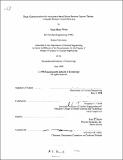| dc.contributor.advisor | Jacquelyn C. Yanch. | en_US |
| dc.contributor.author | White, Susan Marie, 1973- | en_US |
| dc.date.accessioned | 2010-01-07T20:45:23Z | |
| dc.date.available | 2010-01-07T20:45:23Z | |
| dc.date.copyright | 1998 | en_US |
| dc.date.issued | 1998 | en_US |
| dc.identifier.uri | http://hdl.handle.net/1721.1/50491 | |
| dc.description | Thesis (S.M.)--Massachusetts Institute of Technology, Dept. of Nuclear Engineering, 1998. | en_US |
| dc.description | Includes bibliographical references (leaves 62-65). | en_US |
| dc.description.abstract | Use of the ⁹Be(d,n) nuclear reaction for accelerator-based boron neutron capture therapies (AB-BNCT) was investigated. The moderated neutron spectra produced at several deuteron bombarding energies were evaluated in terms of dose rates and dosimetric profiles in a water-filled brain phantom using an existing heavy water moderator and lead reflector assembly. Dosimetry results were obtained using the dual ionization chamber technique coupled with bare and cadmium-covered gold foils. Data have been taken with deuteron beams of 1.3 MeV to 1.8 MeV. As deuteron energy was increased, the tumor dose rate correspondingly improved due to the neutron yield increase. However, the data suggest that the advantage depth decreased, and the ratio of the fast neutron dose rate to the thermal neutron dose rate at a depth of I cm increased, although error bars are significant. All deuteron energies investigated produced a beam that, once moderated, appears viable for AB-BNCT. No conclusion was drawn about the best energy in terms of a high tumor dose rate, a significant advantage depth, and a low fast to thermal neutron dose rate ratio. Treatment times assuming 20 Gy to a tumor located 4 cm deep using a 4 mA accelerator ranged from 18 - 59 minutes, assuming a tumor boron concentration of 40 ppm and RBE values of 1.0 for photons, 3.2 for neutrons, and 3.8 for boron in tumor tissue. The average advantage depth was 6.4 ± 0.7 cm, so these moderated beams could be used to treat tumors near the brain centerline. The ⁹Be(d,n) nuclear reaction is exothermic, and is accessible to inexpensive, small particle accelerators. | en_US |
| dc.description.statementofresponsibility | by Susan Marie White. | en_US |
| dc.format.extent | 65 leaves | en_US |
| dc.language.iso | eng | en_US |
| dc.publisher | Massachusetts Institute of Technology | en_US |
| dc.rights | M.I.T. theses are protected by
copyright. They may be viewed from this source for any purpose, but
reproduction or distribution in any format is prohibited without written
permission. See provided URL for inquiries about permission. | en_US |
| dc.rights.uri | http://dspace.mit.edu/handle/1721.1/7582 | en_US |
| dc.subject | Nuclear Engineering | en_US |
| dc.title | Beam characterization for accelerator-based boron neutron capture therapy using the ⁹Be(d,n) nuclear reaction | en_US |
| dc.type | Thesis | en_US |
| dc.description.degree | S.M. | en_US |
| dc.contributor.department | Massachusetts Institute of Technology. Department of Nuclear Science and Engineering | en_US |
| dc.identifier.oclc | 42254961 | en_US |
